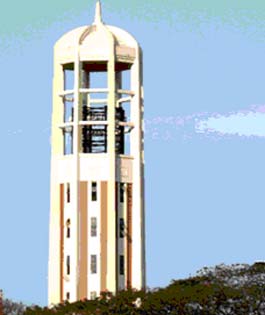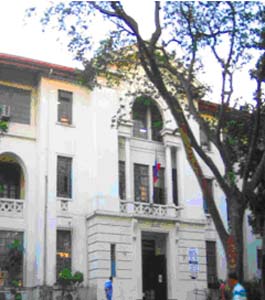|
THE U.P. OBLATION
|
|

|
|
The Oblation is the iconic symbol of the University of the Philippines, represented by a man with arms wide-stretched and face upward, symbolizing selfless offering of one's self to his country.
The Oblation was made by Professor Guillermo E. Tolentino with the help of Anastacio T. Caedo, his student apprentice. According to a book tribute to Guillermo Tolentino, it was Caedo, not director-actor Fernando Poe, Sr. (as popularly rumored), who served as the model for the sculpture. Caedo would later become a professor of Fine Arts in the University. The idea for the Oblation was first conceived by the first U.P. President, Rafael Palma, who was the one to commission Tolentino to make the sculpture. Palma requested that the statue would be based on the second verse of Jose Rizal's "Mi Ultimo Adios".
The original statue was fashioned out of concrete but painted to appear like bronze and was unveiled in 1938. The Oblation, standing at the quadrangle of UP Padre Faura, has withstood the ravages of the war. It was transferred to Diliman in 1949. In 1950, as part of the golden anniversary celebration of the University, the UP Board of Regents ordered that the Oblation be cast in bronze. The bronze statue, supervised by Tolentino, was cast in Italy. This bronze Oblation is the one standing now in front of Quezon Hall, facing the entrance to the University of the Philippines, and the original Oblation is now kept at the UP Main Library.
|
|
THE CARILLON TOWER
|
|

|
|
With the possible exception of the Oblation statue, nothing symbolizes the University of the Philippines more than the 130-foot Carillon Tower - a structure unlike any other in Diliman, a ringing echo of the University's glorious past.
Completed in 1952 … past our high school days … those of us who stayed in college and generations of UP students, teachers, employees, and campus residents were serenaded with its sweet cascade of chimes, rising above the early morning mist and attending the fall of twilight. From UP Beloved - and Planting Rice to the Beatles tunes and The lnternationale of later years, the Carillon grew with the times, and itself grew timeless, marking the same hours of different days as if to remind the listener that some things never change - love, honor, idealism, the joy and the challenge of learning beneath the broad canopy of a university life.
But sad to say, the Carillon has fallen silent, ravaged by age and neglect. The last time the bells were played was at the Lantern Parade in 1988.
However, in the past recent years, Project
|
|
|
|
Carillon, through the efforts of concerned UP groups and, through donations, brought it to life again, restored, and is now chiming as before.
|
|
BENITEZ HALL
COLLEGE OF EDUCATION
|
|

|
|
Where we spent our last 1-1/2 years in High School.
After the World War II Liberation, in 1946 we started out at UP Padre Faura, Manila. Our four sections, together with other year levels, were cramped in a war-strafed building. With the narrow corridors, we could not help bumping into each other so much so camaraderie was easily established among the four sections of third year. Then in 1949, in our mid-third year, we transferred to UP Diliman, to a new building which we shared with the College of Fine Arts, and now named Benitez Hall/College of Education.
Quonset huts left by the U.S. Army proliferated the UP campus. Even the College of Dentistry occupied a big quonset hut. Faculty members lived in most of them.
Wooden red JD buses plied the UP Diliman route for a fare of 15 centavos one way. Although most ate baon under the acacia trees, as the boys reminisced, there was Little Quiapo’s delicious halo-halo when there was extra leftover from our allowance, and small eateries here and there. And if there was a birthday among a group, Max’s at Roces Avenue was the destination where a half spring chicken cost P2.50 and P5.00 for a whole chicken. Soft drinks cost 10 centavos per bottle. No iPod, no walkman then, but there was this jukebox at a canteen where for 10 centavos you could listen to Nat King Cole’s “My Destiny” and “Mona Lisa”, and other favorite singers.
|
|
CHURCH OF THE HOLY SACRIFICE
|
|

|
|
From a small, simple chapel in 1950, with the then gentle Fr. John Patrick Delaney guiding the student and faculty populace in their spiritual needs, the Chapel of the Holy Sacrifice is now a big domed church under the Roman Catholic Diocese of Cubao,
In 1955, the controversial but charismatic Jesuit chaplain orchestrated the project of turning the small chapel into a building that would accommodate the increasing UP population. The dome of the church is supported by pillars located at the sides of the church, so that there are no supports to block the space inside. The unique design of the dome allows natural lighting and ventilation. At the middle of the dome is a circular skylight, which supports the triangular bell tower. The bell tower then extends to the interior, supporting the crucifix. The arrangement of the interior of the church is concentric, with the altar in the middle. The back-to-back crucifix hanging from the middle of the ceiling is one of the church’s beautiful highlights.
Known for its architectural design, the church is recognized as a National Historical Landmark and a Cultural Treasure by the National Historical Institute and the National Museum, respectively. It was designed by the late National Artist for Architecture, Leandro Locsin, who was only one of the five national artists who collaborated on the project. Alfredo Juinio served as the structural engineer for the project.
|
|

